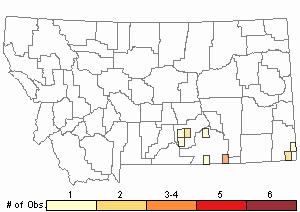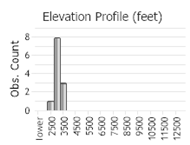View in other NatureServe Network Field Guides
NatureServe
Montana
Utah
Wyoming
Idaho
Wisconsin
British Columbia
South Carolina
Yukon
California
New York
Calico Crayfish - Faxonius immunis
Other Names:
Orconectes immunis
General Description
Rostrum acuminate, acarinate and with converging margins lacking marginal spines or shoulders; cervical spines present; areola narrow with 2-3 punctations in narrowest part; male with hooks on ischia of 3rd pereiopods; male first pleopod terminating in 2 subparallel elements <25% length of pleopod, curved throughout length but distal 1/3 more pronounced so that apices of both elements directed at about 90 degrees to main axis of pleopod (Page 1985).
Diagnostic Characteristics
O. immunis have characteristically long, slender chelae with a very splotchy coloration, but these features are a bit difficult to use as diagnostic characters without a few reference specimens. The easiest way to distinguish between O. immunis and O. virilis is the notch near the base of the dactyl, or 'thumb' of the cheliped--O. immunis has it, O. virilis does not.
Species Range
Montana Range
Range Descriptions

 Native
Native
Range Comments
O. immunis has a widespread North American native range from southern Quebec, Canada and New England westward across the upper Midwest to Wyoming and eastern Colorado and the Dakotas and south to extreme northwestern Tennessee (Hobbs 1989 and Pflieger et al. 1996). Montana's eastern plains populations are the furthest reported western extent this species ranges.
Observations in Montana Natural Heritage Program Database
Number of Observations: 14
(Click on the following maps and charts to see full sized version)
Map Help and Descriptions
Relative Density

Recency



 (Observations spanning multiple months or years are excluded from time charts)
(Observations spanning multiple months or years are excluded from time charts)
Migration
Does not seem to migrate any large distance and often burrows and maintains a very small home range
Habitat
The species is always in, at best, sluggish flow (unlike O. virilis which can tolerate moderately flowing rivers); burrows during drying periods (i.e., tertiary burrower). In Missouri, it occurs in shallow ditches and sloughs on the broad, flat flood plains of large to medium-sized rivers and in the isolated pools of intermittent headwater streams draining level upland prairies. Wide seasonal fluctuations in water area and depth (with many areas becoming entirely dry during late summer), deep mud bottoms and absence of strong flow or current are common characteristics of these habitats. However, large populations also occurred in habitats where high turbidity provided the only cover (Pflieger et al. 1996).
Food Habits
This species is an omnivorous detritivore and a scavenger, feeding by shredding large pieces of orangic materials and shredding them up.
Management
In eastrern Montana, this species may be becoming rare and out-competed due to the invasive nature of the Virile Crayfish
Stewardship Responsibility
Threats or Limiting Factors
Invasive crayfish species Orconectes virilis
References
- Literature Cited AboveLegend:
 View Online Publication
View Online Publication Hobbs, H.H. Jr. 1989. An illustrated checklist of the American crayfishes (Decapoda: Astacidae, Cambaridae & Parastacidae). Smithsonian Contributions to Zoology, 480: 1-236.
Hobbs, H.H. Jr. 1989. An illustrated checklist of the American crayfishes (Decapoda: Astacidae, Cambaridae & Parastacidae). Smithsonian Contributions to Zoology, 480: 1-236. Page, L.M. 1985. The crayfishes and shrimps (Decapoda) of Il linois. Illinois Nat. Hist. Surv. Bull 33(4):335-448.
Page, L.M. 1985. The crayfishes and shrimps (Decapoda) of Il linois. Illinois Nat. Hist. Surv. Bull 33(4):335-448. Pflieger, W.L., B. Dryden, and S. Faiman. 1996. The Crayfishes of Missouri. Jefferson City, MO: Missouri Department of Conservation.
Pflieger, W.L., B. Dryden, and S. Faiman. 1996. The Crayfishes of Missouri. Jefferson City, MO: Missouri Department of Conservation.
- Additional ReferencesLegend:
 View Online Publication
View Online Publication
Do you know of a citation we're missing? Kennedy, H.L. and S.B. Adams. 2025. Interdisciplinary approaches improve understanding of cryptogenic species: A historical case study of crayfish in Montana, USA. Wiley Interdisciplinary Reviews Water 12:e70014
Kennedy, H.L. and S.B. Adams. 2025. Interdisciplinary approaches improve understanding of cryptogenic species: A historical case study of crayfish in Montana, USA. Wiley Interdisciplinary Reviews Water 12:e70014
- Web Search Engines for Articles on "Calico Crayfish"
- Additional Sources of Information Related to "Crayfish / Amphipods / Pill Bugs"





